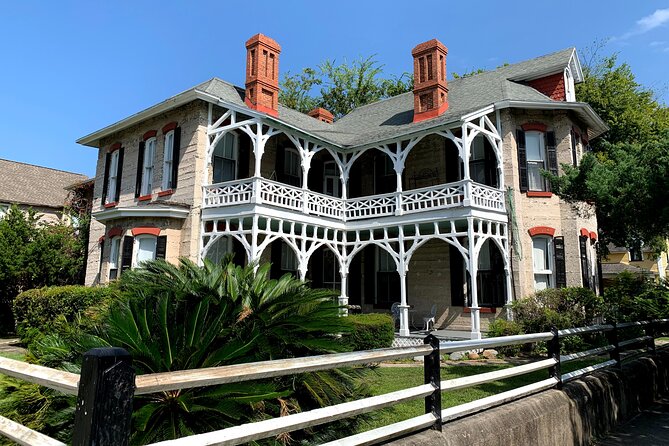Amelia Island’s storied past unfolds through the Eight Flags Road Tour, a captivating journey that explores the island’s rich cultural heritage. From the indigenous Timucua to Spanish colonists, British rule, and the shrimping industry, this comprehensive tour takes visitors on a captivating exploration of the island’s pivotal role in colonial conflicts and its enduring legacy as a unique and historically significant destination. With an air-conditioned minibus, the tour offers a deep dive into the diverse tapestry that has shaped this strategically located island – and leaves one eager to discover more about its intriguing history.
Key Points

- The Eight Flags Road Tour provides a rundown of Amelia Island’s captivating history, from indigenous Timucua to modern shrimping.
- The tour explores the island’s strategic location and its role in colonial conflicts under Spanish, British, and American rule.
- Visitors can learn about the influential Timucua tribe, their cultural traditions, and their lasting legacy on Amelia Island.
- The tour highlights the island’s Spanish colonial influence, British economic development, and its reputation as a haven for pirates.
- The tour also delves into Amelia Island’s antebellum period, the Civil War, and the enduring significance of the local shrimping industry.
Overview of Amelia Island

Amelia Island’s rich history spans centuries, from the indigenous Timucua people to the modern shrimping industry that thrives along its shores.
This small-group sightseeing tour takes visitors on a journey through the island’s captivating past. Aboard an air-conditioned minibus, travelers will discover the different phases of local history, learning about the Timucua, Spanish explorers, British loyalists, and more.
The tour delves into Amelia Island’s strategic location, its role in colonial conflicts, and its transformation into a hub for trade and commerce.
Whether you’re a history buff or simply curious about the region, this guided excursion offers a rundown of Amelia Island’s fascinating heritage.
You can also read our reviews of more tours and experiences in Jacksonville.
Timucua Indian History

The Timucua were a Native American people who inhabited northeastern Florida and southeastern Georgia for centuries before European contact. They played a significant role in the early history of Amelia Island, as their territory encompassed the island and the surrounding region.
The Timucua people were known for:
- Their advanced agricultural practices, which included cultivating corn, beans, and squash.
- Their skilled construction of dugout canoes and elaborate ceremonial structures.
- Their complex social organization, with a hierarchical leadership system and specialized roles within their communities.
- Their rich cultural traditions, including storytelling, music, and a unique language.
The Timucua’s legacy on Amelia Island remains an important part of the island’s history, as visitors can learn about their influence during the guided tour.
Arrival of Spanish Colonists
In the 16th century, Spanish colonists first arrived on Amelia Island, marking a new chapter in the island’s history and forever shaping its cultural and political landscape.
The Spanish established a settlement, Fort San Carlos, and began cultivating crops and livestock. They also introduced Catholicism to the island, building a mission to convert the native Timucua people.
Over the next two centuries, control of Amelia Island changed hands several times between the Spanish, English, and United States, reflecting the strategic importance of the island’s location.
Despite these shifts, the Spanish colonial influence remained strong, leaving an enduring imprint on the architecture, language, and traditions of the island.
Amelia Island Under British Rule

After the Spanish ceded control of Amelia Island in the early 19th century, the British quickly established a presence on the strategically located island. They recognized its potential as a hub for trade and commerce, and invested heavily in infrastructure development and economic ventures.
Over the next few decades, Amelia Island flourished under British rule:
- The construction of Fort Clinch, a massive coastal fortress, solidified the island’s military importance.
- The hotel of a thriving timber industry, exporting high-quality lumber to the British colonies.
- The growth of a prosperous shipping industry, with the port of Fernandina serving as a vital gateway for trade.
- The influx of British settlers, who brought their culture, customs, and architectural styles to the island.
Amelia Island’s Pirate Era

Amelia Island’s strategic location along major maritime trade routes made it a prime target for notorious pirates during the late 18th and early 19th centuries. Daring buccaneers like the legendary Blackbeard and Anne Bonny terrorized the island, seizing merchant ships and plundering coastal settlements.
Visitors can learn about this colorful period of Amelia Island‘s history on the Eight Flags Road Tour. The tour guides recount tales of pirate raids, dramatic sea battles, and hidden caches of buried treasure.
Participants will also discover how the island’s Spanish, French, and British colonial heritage contributed to its reputation as a haven for lawless privateers.
From the Golden Age of Piracy to the modern shrimping industry, the Eight Flags Road Tour offers a captivating glimpse into Amelia Island’s rich and diverse past.
The Antebellum Period

The island’s prosperous antebellum period saw its economy flourish as wealthy plantation owners grew lucrative crops like sea island cotton and citrus fruits on large estates.
This era ushered in a new phase of Amelia Island’s history marked by:
- The rise of a plantation economy with slave labor.
- The construction of ornate mansions and grand estates.
- The expansion of Fernandina’s port facilities to accommodate increased trade.
- The emergence of a thriving social elite that shaped the island’s culture and politics.
Despite the economic growth, this period also brought profound societal inequalities that would eventually lead to the American Civil War and the end of the antebellum era on Amelia Island.
Amelia Island in the Civil War

During the tumultuous years of the American Civil War, Amelia Island found itself at the center of key events that shaped the region’s history. The island’s strategic location along the Atlantic coast made it a prized target for both Union and Confederate forces, leading to a series of clashes and occupations that left a lasting mark on the island’s development.
In 1862, the Union forces seized control of Amelia Island, recognizing its importance as a Confederate staging ground. The island changed hands several times over the course of the war, witnessing skirmishes and battles that disrupted local economies and communities.
This turbulent period left a complex legacy that’s still evident in the island’s rich historical tapestry.
Modern Shrimping Industry

Beyond the island’s Civil War legacy, Amelia Island has long been known for its thriving shrimping industry, which continues to play a vital role in the local economy and culture to this day.
The industry dates back decades, with local fishermen harvesting the abundant shrimp found in the island’s coastal waters.
Today, the industry remains a cornerstone of Amelia Island’s identity, supporting:
- A fleet of commercial shrimping vessels that dock at the island’s marinas.
- Processing facilities that prepare the catch for distribution across the region.
- Restaurants and seafood markets that feature Amelia Island shrimp on their menus.
- Festivals and events that celebrate the island’s shrimping heritage.
This rich tradition endures, offering visitors a glimpse into Amelia Island’s enduring maritime culture.
Frequently Asked Questions
What Is the Tour Group Size Limit?
The tour group size is limited to a maximum of 10 travelers. This small-group sightseeing tour allows for a more personalized experience as the guide can provide more attention to each guest.
What Time Does the Tour Start?
The tour starts at a flexible time, with the meeting point at Amelia Island Historic Tours. Travelers should check the tour details for the specific departure time, as it may vary depending on factors such as the tour group size.
What Is the Dress Code for the Tour?
There is no specific dress code for the Amelia Island Historic Tours. Visitors should wear comfortable, weather-appropriate clothing and closed-toe shoes, as the tour involves walking outside. Casual attire is acceptable for this small-group sightseeing experience.
Are There Any Age Restrictions for the Tour?
The tour does not have any age restrictions. Travelers of all ages are welcome to join the small-group sightseeing tour, which is designed to be informative and suitable for a diverse audience.
Can I Bring My Pet on the Tour?
The tour company does not allow pets on the sightseeing tour. Pets are not permitted in the air-conditioned minibus for the safety and comfort of all passengers. Guests are advised to make alternative arrangements for their pets during the tour.
Recap
The Eight Flags Road Tour provides a comprehensive journey through Amelia Island’s captivating history, from its indigenous Timucua roots to its modern-day shrimping industry.
Visitors can explore the island’s pivotal role in colonial conflicts and its enduring legacy as a unique and historically significant destination, all while immersed in the diverse cultural and historical tapestry that has shaped this strategically located island.
More Tours in Jacksonville
More Tour Reviews in Jacksonville
Not for you? Here's more things to do in Jacksonville we have recnetly reviewed
- Adventurous Scavenger Hunt in Jacksonville by Wacky Walks
- Luxury JAX Airport Transportation From St. Johns Town Center
- Luxury JAX Airport Transportation From Ponte Vedra
- Private Transfer From Jacksonville to Orlando (Mco) Airport
- Private Transfer From Saint Johns to Port Canaveral
- Luxury JAX Airport Transportation From Jacksonville Beach
- Jacksonville Private Boat Tour Daytime or Sunset, up to 6 People
- Riverside/5 Points Culinary Tour (Jacksonville)
- Luxury Car Transfer Jacksonville Airport to Ponte Vedra Resorts
- 1 Hour Chocolate Popcorn Making Class in Jacksonville
- Jax Brewery Tour (Drinks Included)
- Electric Bike Tour With Free Application for Navigation
